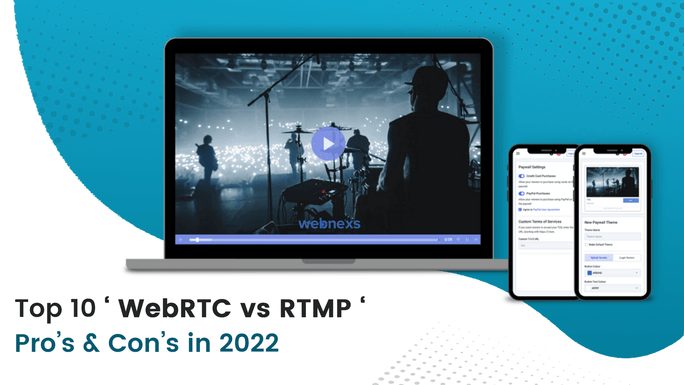Ready to switch with WebRTC? Get Started here

WebRTC – Web Real-Time Communications, has been around for almost a decade. During that time, the open-source project has completed from an emerging technology to a mainstream standard for many streaming applications.
The emerging end of Flash and growing demand for influencing streaming experiences set the stage for WebRTC. From there, support over all popular browsers caused universal assumption.
What is WebRTC?
WebRTC is the framework that combines protocols and interfaces to reach what its name promises: real-time communications through the web. Whereas video conferencing could once only take place with a plug-in or app, WebRTC permits users to begin click-to-start video chats using only their browsers.
Recently, Google Hangouts, Facebook Messenger all make use of WebRTC within their services. Google has stated that WebRTC is supported by Chrome, Edge, Firefox, and Safari, more than 85% of all installed browsers globally have become a client for real-time communications on the internet.”
At its depths, WebRTC was developed for peer-to-peer communication across a limited number of browsers. However, by including a media server to their WebRTC streaming solutions, content distributors can expand the framework’s out-of-the-box capabilities and broadcast live streams to any destination.
Considerations When Implementing WebRTC
Points to be consider when implementing WebRTC in comparison with RTMP:
Required Two-Way Video or Real-Time Interactivity
When you are using WebRTC for both publishing and playback, latency must be under 500 milliseconds in good network conditions, facilitating real-time interactions. If you could choose to delay the playback time or synchronize playback between various devices, you may need to capture with WebRTC and use HLS for playback, thereby supporting metadata and timecode to manage the time you want noted from playback.
Go viral
At the present, WebRTC is very ample in its capacity to scale past a few thousand instances without a huge network of live-repeating servers. Because WebRTC uses peering networks, there still has to be a nearby node to assist distribute the stream to other local hosts and peering between a global network can be extremely hard.
For large-scale broadcasts, a live streaming server must be used to transcode the WebRTC stream into a protocol like HLS for division to thousands. That way, content distributors can integrate easy, browser-based publishing with large-scale broadcasting.
Broadcast-quality streams
Due to bitrate limitations, WebRTC lacks in quality. While browser-based contribution is essentially connectivity- and camera-dependent on the intention front, high-bitrate encoding is still feasible.
For broadcast-quality streaming, you’ll want to send the highest-quality source to your transcoder and transcode into adaptive bitrate streaming for seamless playback on a lot of devices.
RTMP vs WebRTC : Strengths and Limitations.
Latency
RTMP is based on Transmission Control Protocol (TCP), and it enables data transmission in a given sequence and order with delivery guarantee. Even if it implements more authentic network connection, latency is often 0.5 seconds or more dependent on network settings.
WebRTC is based on User Datagram Protocol(UCP), and it provides near real-time latency with less than 0.1s. Therefore WebRTC is feasibly better for two-way conferencing or real-time device control.
Learn more about : Low Latency Streaming Platform
Scalability
RTMP can be climbed to offer live streaming to thousands or even millions of audiences. In difference, WebRTC is often used to offer live streaming to a smaller number of audiences, normally within a thousand limits. but, this is sustainable, as some people explain that the Peer-to-Peer nature of WebRTC will not cause scalability issues if implemented properly. But when it comes to scaling, RTMP is certainly taking the lead. For use cases that need live streaming to thousands of viewers, RTMP is the preferable choice.
Encoder/Player and Browser Support
Due to the vast assumption of RTMP, it is assisted by most encoder software and video players. However, due to the end of live of the Flash player, it creates to lose support by modern browsers. WebRTC has preferable support by modern browsers with built-in API support in HTML5, and can be played within most modern browsers without installing any software or plugins. In terms of encoder or video player support, more software vendors create to understand the popularity of WebRTC, and create to include WebRTC into their support list.
Cloud Support
Several cloud providers such as AWS or Alibaba Cloud have video streaming services that can be directly combined with RTMP. For example Alibaba Cloud that is consistent with RTMP. In variation, to run video streaming using WebRTC, we will need to install on-promise streaming servers such as Jitsi Meet on to the cloud.
API Support
When it comes to development, API support is a major factor for selecting your technology. WebRTC is taking the help for API support, as most modern browsers have native API integrated with WebRTC, and can be called directly using Javascript. On the other hand, to move with RTMP, we will want to support open source libraries, or utilize pre-existing software solutions such as OBS.
Since Both technologies have their own strengths and limitations, they can be choosed interchangeably based on the use case, dev efforts/timeline, and people’s skills. Here, at Webnexs, we offer tools for both RTMP and WebRTC platforms. Contact us today or get a free consultation over which one to use. We have set to run tools, software and platforms that will expedite your time to market.



1 Responses
WebRTC delivers various benefits over RTMP. but, the open-source framework is the standardarized